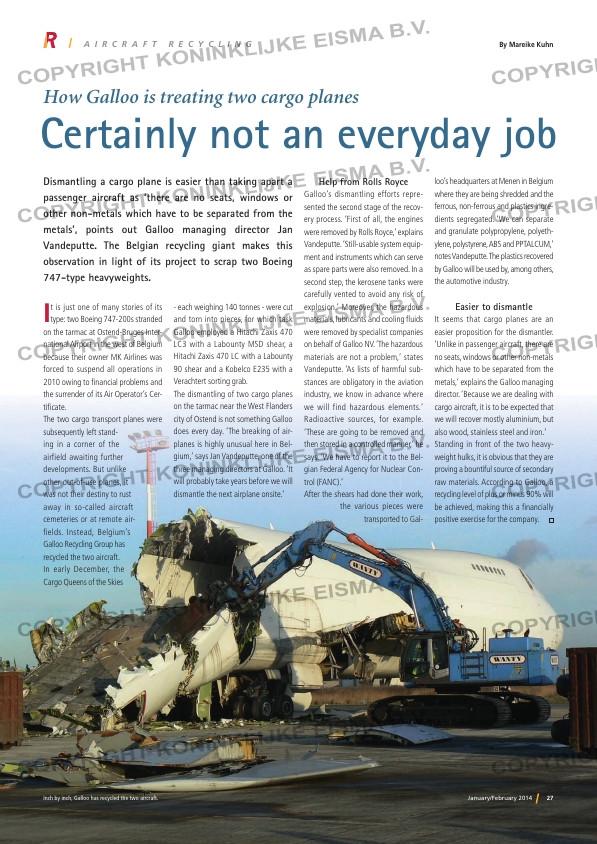Page 27 from: January / February 2014

27January/February 2014
Certainly not an everyday job
Dismantling a cargo plane is easier than taking apart a
passenger aircraft as ‘there are no seats, windows or
other non-metals which have to be separated from the
metals’, points out Galloo managing director Jan
Vandeputte. The Belgian recycling giant makes this
observation in light of its project to scrap two Boeing
747-type heavyweights.
It is just one of many stories of its type: two Boeing 747-200s stranded
on the tarmac at Ostend-Bruges Inter-
national Airport in the west of Belgium
because their owner MK Airlines was
forced to suspend all operations in
2010 owing to fi nancial problems and
the surrender of its Air Operator’s Cer-
tifi cate.
The two cargo transport planes were
subsequently left stand-
ing in a corner of the
airfield awaiting further
developments. But unlike
other out-of-use planes, it
was not their destiny to rust
away in so-called aircraft
cemeteries or at remote air-
fields. Instead, Belgium’s
Galloo Recycling Group has
recycled the two aircraft.
In early December, the
Cargo Queens of the Skies
– each weighing 140 tonnes – were cut
and torn into pieces, for which task
Galloo employed a Hitachi Zaxis 470
LC3 with a Labounty MSD shear, a
Hitachi Zaxis 470 LC with a Labounty
90 shear and a Kobelco E235 with a
Verachtert sorting grab.
The dismantling of two cargo planes
on the tarmac near the West Flanders
city of Ostend is not something Galloo
does every day. ‘The breaking of air-
planes is highly unusual here in Bel-
gium,’ says Jan Vandeputte, one of the
three managing directors at Galloo. ‘It
will probably take years before we will
dismantle the next airplane onsite.’
Help from Rolls Royce
Galloo’s dismantling efforts repre-
sented the second stage of the recov-
ery process. ‘First of all, the engines
were removed by Rolls Royce,’ explains
Vandeputte. ‘Still-usable system equip-
ment and instruments which can serve
as spare parts were also removed. In a
second step, the kerosene tanks were
carefully vented to avoid any risk of
explosion.’ Moreover, the hazardous
materials, lubricants and cooling fl uids
were removed by specialist companies
on behalf of Galloo NV. ‘The hazardous
materials are not a problem,’ states
Vandeputte. ‘As lists of harmful sub-
stances are obligatory in the aviation
industry, we know in advance where
we will find hazardous elements.’
Radioactive sources, for example.
‘These are going to be removed and
then stored in a controlled manner,’ he
says. ‘We have to report it to the Bel-
gian Federal Agency for Nuclear Con-
trol (FANC).’
After the shears had done their work,
the various pieces were
transported to Gal-
loo’s headquarters at Menen in Belgium
where they are being shredded and the
ferrous, non-ferrous and plastics ingre-
dients segregated. ‘We can separate
and granulate polypropylene, polyeth-
ylene, polystyrene, ABS and PPTALCUM,’
notes Vandeputte. The plastics recovered
by Galloo will be used by, among others,
the automotive industry.
Easier to dismantle
It seems that cargo planes are an
easier proposition for the dismantler.
‘Unlike in passenger aircraft, there are
no seats, windows or other non-metals
which have to be separated from the
metals,’ explains the Galloo managing
director. ‘Because we are dealing with
cargo aircraft, it is to be expected that
we will recover mostly aluminium, but
also wood, stainless steel and iron.’
Standing in front of the two heavy-
weight hulks, it is obvious that they are
proving a bountiful source of secondary
raw materials. According to Galloo, a
recycling level of plus or minus 90% will
be achieved, making this a fi nancially
positive exercise for the company.
A I R C R A F T R E C Y C L I N G By Mareike Kuhn
How Galloo is treating two cargo planes
Inch by inch, Galloo has recycled the two aircraft.
RI-1-2014-Galloo-Aircraft.indd 27 29-01-14 14:54



